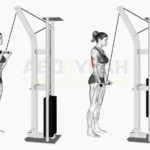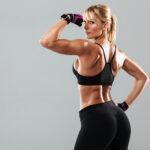Dumbbell Lateral Raise: Exercise Overview
The dumbbell lateral raise is a highly effective isolation exercise designed to target the deltoid muscles, particularly the lateral (middle) head, which contributes to broader shoulders and a defined “V-shaped” upper body. This movement enhances shoulder strength and aesthetics, making it a staple for those aiming to sculpt a balanced physique. By isolating the deltoids, the dumbbell lateral raise supports improved shoulder stability and appearance, ideal for both aesthetic goals and functional upper-body strength. It can be incorporated into shoulder workouts, upper-body sessions, or full-body routines to promote well-rounded development (Schoenfeld, 2010).
How to Perform the Dumbbell Lateral Raise
- Select an appropriate pair of dumbbells from the rack and step back into an open area, standing with feet shoulder-width apart.
- Hold the dumbbells at your sides with a neutral grip (palms facing inward), keeping your elbows slightly bent.
- Inhale deeply, engage your core, and raise the dumbbells out to your sides until your arms reach shoulder height.
- Pause briefly at the top, focusing on contracting the lateral deltoids.
- Slowly lower the dumbbells back to the starting position with control, exhaling as you descend.
- Repeat for the desired number of repetitions.
Tips for Optimal Performance
- Control the Movement: Perform the raise and descent slowly to maximize deltoid engagement and avoid using momentum, which enhances muscle activation and reduces injury risk (Schoenfeld, 2016).
- Limit Arm Height: Raise the dumbbells only to shoulder level to prevent excessive strain on the shoulder joint and minimize the risk of impingement (Escamilla et al., 2009).
- Adjust for Shoulder Comfort: If you experience shoulder discomfort, try one of these tweaks:
- Angle your pinkies slightly higher than your thumbs, as if pouring water from a cup, to reduce joint stress.
- Rotate your palms forward so your thumbs point outward, promoting external shoulder rotation and opening the shoulder joint for smoother movement.
- Engage Your Core: Brace your abdominal muscles to maintain a stable torso and prevent swaying or arching your back.
- Breathe Properly: Inhale as you prepare to lift and exhale as you lower the dumbbells to support controlled movement and muscle oxygenation.
- Choose the Right Weight: Select a weight that allows you to maintain proper form for your target rep range (e.g., 10–15 reps for hypertrophy) to avoid compensatory movements.
Building broad shoulders with lateral raises? Learn their role in our Ultimate Guide to Muscle Groups for shoulder strength.







